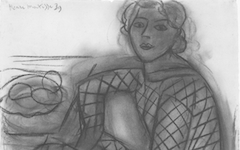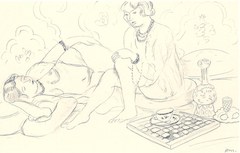Matisse’s View of Notre-Dame (1914)

Matisse, View of Notre-Dame (1914) Oil on canvas. Kunstmuseum Solothurn, Switzerland.
Click image to enlarge.
Notre-Dame was more important to Matisse than you might imagine. By 1914 he had spent all but seven years of his adult life in a building opposite the cathedral with a window overlooking it. After a few years on the outskirts of Paris he moved back to the city center in 1914 into a different building but still with a view of France's most holy symbol. He painted two views of Notre-Dame, as seen from his window, in 1914 with the one at left more illusionistic than the other.
Click next thumbnail to continue

Matisse, View of Notre-Dame (1914) Oil on canvas. Museum of Modern Art, New York
Click image to enlarge.
As the First World War approached, Matisse's biographer noted that he pared down his life like his art. The nature of perception was then a hot topic and Matisse, responding to the advances of photography and Picasso's Cubist abstractions, re-painted the cathedral as a "weightless, see-through, floating cube enclosed in black shadows, lines or scratchings on a sky-blue ground."1 Most contemporaries naturally preferred the first version; our eyes today, I believe, prefer the second. What, though, do they mean?
Click next thumbnail to continue
As shown in the diagram, both towers are drawn like an M for Matisse as is the small arcade on the building to its left (in oval), two flowing Ms with a tiny, more precise one further left. As always the scene is Matisse's mind whether mimetic or abstract. It implies that his soul, at the creative moment, is so pure that God guides his hand making him both divine and the greatest French painter of the day.2 This is all in his head so the bridge forms his right "eye" with the river Seine and its life-giving waters running through it; the embankment is the line of his "nose" with his left "eye", the one traditionally linked to external reality, out-of-view on the Left Bank. Notre-Dame then rises above his right eye, the one thought to see "inwards".
Click next thumbnail to continue
Nor does it matter whether Matisse believed in God. He once told a nun, truthfully, that he was God. We all are, deep inside. [See Inner Tradition.] The abstract version of Notre-Dame, the one more suited to modernity, still forms a giant M with the two vertical towers also suggesting an H (Henri) as well. The foreground lines resemble an underdrawing (thus implying a mental image) with the bridge's curve again as his "eye". A green bush, the color of creativity, seems to hover over a flat surface, further suggesting that the painting is a mental image of a painting.
Click next thumbnail to continue

L: Matisse, Notre-Dame (1902) Oil on canvas. 16" x 13"
R: Diagram of painting above
Lower L: Matisse, Self-portrait (1900)
Click image to enlarge.
A small sketch of Notre-Dame that Matisse had painted a decade earlier proves, at least to me, that he thought of the cathedral as his own mind. Compare the diagram to the original on the left and you will see his "eyes" in the towers, the tip of his "nose" in the circular rose window and a mass of green underneath as his beard. Remarkably, it even resembles him (below.) There may also be a slight reflection of his face in the water under the bridge but, of that, I am not certain.
Monet imagined Rouen Cathedral as his mind using a similar method as did Michelangelo in the Sistine Chapel. There are others too. Few but artists, however, have ever seen this so your new perception is rare.
More Works by Matisse
See how Matisse's identification with an earlier artist is conveyed in a businessman's portrait

Matisse’s Portrait of Auguste Pellerin II (1917)
Notes:
1. Spurling, Matisse the Master: The Conquest of Colour, 1909-1954 (New York: Alfred A. Knopf), p. 147
2. Picasso, of course, was Spanish so that this view may even have been the product of their rivalry; Picasso could not have painted it.
Original Publication Date on EPPH: 08 Oct 2012. | Updated: 0. © Simon Abrahams. Articles on this site are the copyright of Simon Abrahams. To use copyrighted material in print or other media for purposes beyond 'fair use', you must obtain permission from the copyright owner. Websites may link to this page without permission (please do) but may not reproduce the material on their own site without crediting Simon Abrahams and EPPH.




